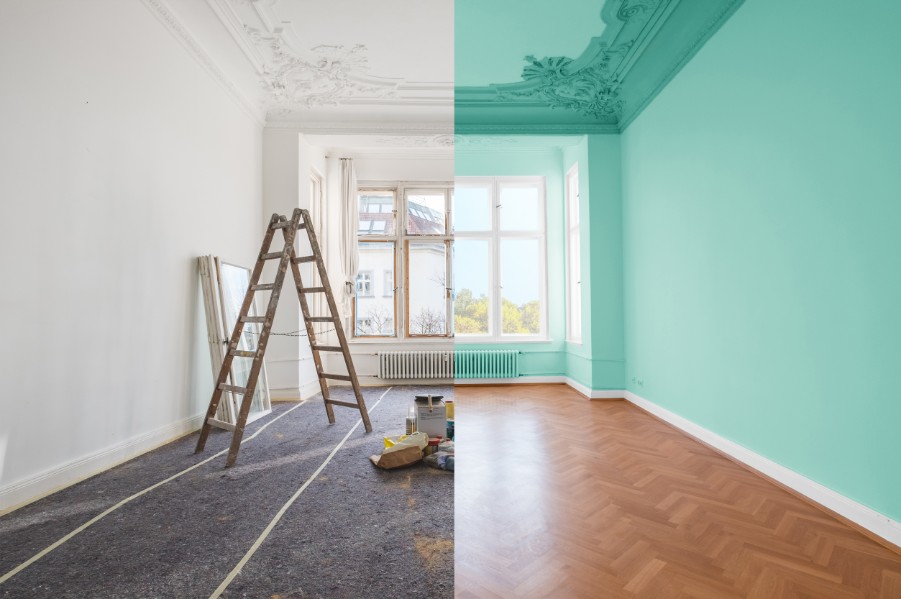Can you use wall paint on ceilings
A single coat on wall can be covered entirely using ceiling paint, which is made expressly for this purpose. It is frequently sold and can be less expensive than colorful wall paint. Compared to other paints, these finishes have a slight issue.
While wall paints are available in a vast assortment of hues and tones, ceiling paint is typically only available in the color white. This could be an issue if you want to paint your ceiling the same color as your walls or trim.
There are various ceiling paint varieties, including standard interior paint. You can use the same paint on your walls and ceiling, but since wall paint is typically thin and has a low viscosity, it is prone to spill when painted so its is advised to use thick paint on wall as well if you plan to use it on ceiling or you use less thinner/mixer with paint when using wall paint on ceilings for best results post your paint job.

Knowing the distinction between the two types of ceiling paint will help you avoid choosing plain white ceiling paint. What you learn might surprise you!
Function
Ceiling paint is designed to dry more quickly and splash less than wall paint, and it easily covers scuffed edges and flaws. Since it is made to dry more quickly, it is usually simpler to deal with while painting overhead.
On the other hand, the production of wall paint makes it more resilient, wipes better, and burnishes less, making it equally ideal for ceilings as ceiling-specific paint.
But unlike ceiling paint, wall paint is available in a wide variety of color tones, making it simple to match any existing hues in your room. However, this issue can be quickly addressed by bringing it to a hardware or paint store, where they can color the white paint by adding pigment or tint. This will allow the walls and ceiling of your room to share the same color palette.
Types
Although oil-based wall and ceiling paints were formerly the industry standard, water-based latex is currently the most effective option. It is perfect for both ceiling and wall paints. The latex type dries quicker and has less solvent odor than the oil-based type.
Considerations
The objective of ceiling paints is to scatter light rather than reflect it, covering any flaws. Their matte finish is intended to prevent glares from light that enters through windows or doors.
Additionally, ceiling paints can conceal various flaws and reduce roller marks because of this finish. However, eggshell or satin paint can also be used on your ceiling because they have similar finish qualities. if you are wondering how many times can you paint your wall then here is your answer for this question.

Do the paint on the walls, and the ceiling differ from one another?
Paint has been applied to the ceiling’s margins to cover any flaws. Any little flaws are not highlighted but are somewhat concealed from view because it is flat and does not reflect light. The wall’s paint was more enduring, making it simple to clean with soap and water.
Are flat paint and ceiling paint the same thing?
Compared to other finishes, ceiling paint has a flat paint sheen nine times more frequently. This is because ceilings should merge in rather than disappear. Gloss finishes typically do not draw attention to the ceiling as flat sheens do. know the difference between flat paint eggshell paint which is use on wall more in this post.
I want to paint my ceiling, what kind of paint should I use?
It is usually always advisable to use flat, matte acrylic paint to paint the ceiling. Because of the following factors: Flat paint will not reflect light or detract from the room’s furniture. Because the ceiling does not see significant wear and tear, glossy, long-lasting paint is not required.
What quality of Paint Finish is good For room Ceilings?
Flat white is typically the perfect paint finish for ceilings because it minimizes glare from artificial overhead lighting and reflects natural light around the space, giving it a more open, bright air.
Do I Have to Paint My Ceiling With Ceiling Paint?
The ceiling paint is intended to be applied to the ceiling. You only need one coat to cover all the flaws, so there won’t be any splatters or defects. Depending on the hue, you could need two or more coats to get the desired effect compared to wall paint, which is thinner.
Which Paint Type Do You Apply To Ceilings?
Although it is not stated in writing, the majority of expert painters use flat, matte acrylic paint for ceilings. An even flat paint finish does not reflect light or produce glares.
Can You Paint Ceilings And Walls With The Same Paint?
Flat ceiling paint is the greatest option for painting walls since it enables you to use paint with a flat, eggshell, satin, or pearlescent finish, especially if your ceiling is smooth. It is feasible to paint walls with the same sheen ceiling paint.
Which Paint Type Is Best For Interior Ceilings?
- Ensure that the inside paint you select is latex.
- To avoid drips, make sure the paint has a high viscosity.
- You can select a low-luster or no-luster shine.
- When it comes to convincing sceptics, white paint has a winning finish…
- Here are nine techniques to defend against attacks on low ceilings.
- Texture paint can be used to texture ceilings.

Is it acceptable to use wall paint on the ceiling?
Cover it with wall paint to make it appear as though you are painting your ceiling. However, normal wall paint is thinner in thickness. Because of the lower viscosity, there can be more spills and drips. Make sure the paint sheen is the same on the walls and the ceiling if you want the best results.
Are Ceiling Paint And Regular Paint Distinct From One Another?
There are various ceiling paint varieties, including standard interior paint. You can use the same paint you used on your walls and ceiling, but since wall paint is typically thin and has a low viscosity, it is prone to spill when painted. Only ceilings without textures should have paint applied to them.
Are ceiling paint and flat paint interchangeable?
Low ceilings benefit from flat paint since they blend in well with the material and have a glossy finish. A glossy finish is usually the best choice for roofs because it doesn’t draw attention away from the roof. The primary ingredient in ceiling paint is a flat paint sheen.
Does flat white paint tends to be same as room ceiling paint?
Applying regular flat sheen white interior latex paint that is not designated as ceiling paint will result in a flat, white ceiling. However, utilizing ceiling paint will speed up the process, produce a ceiling that looks better, and cause fewer drips and splatters.
Does Ceiling Flat Paint Work?
Contrary to other types of paint that need more time to dry, flat paint dries evenly and is simple to apply to a ceiling with little dripping. Flat paint should not be used in moist areas like bathrooms, basements, or laundry rooms since the moisture can cause the paint to chip, peel, or stain.
Can Wall Paint Be Used On Ceilings?
Interior walls, doors, and trim can all be painted before painting ceilings. If you want the walls to have a flat finish and a comparable color, it is advisable to accomplish this and use wall paint on ceilings too. A contemporary interior design technique is sometimes employed to add texture to living rooms and use wall paint on ceilings if your design element is contrasting or matching with ceilings.
Are ceiling paints more or less flat?
Ceiling paint often has a flat sheen, but a wall or drywall has a semi-gloss finish that conceals flaws.
Do Ceilings Require Special Paint?
The ceiling is not painted with standard interior paint. You can use the same paint on your walls and ceiling, but since wall paint is typically thin and has a low viscosity, it is prone to spill when painted.
Is flat or eggshell paint better for ceilings?
Flat latex paint is typically used to paint textured ceilings. Eggshell or satin paint can provide a flat ceiling with no rough textures or popcorn coating a glossy sheen.
Should I apply regular paint or ceiling paint?
Greater Ceiling Paint Viscosity Slows Drips and Splatter However, utilising ceiling paint will speed up the process, improve the ceiling’s appearance, and cause fewer drips and splatters. Latex paint that is viscous is not as thick as conventional latex paint. It is possible to compare wall and ceiling paints.
The ideal sheen for ceilings is what?
When painting ceilings, flat or matte sheens are nearly always preferable. If there are numerous flaws in your ceiling, a flat paint finish will work best. Another way to prevent textured plaster from standing out from sharp angles of light coming from windows or ceiling lights is to give ceilings a flat shine.
The perfect finish for ceilings is?
Points of completion for ceiling paints. Although it might vary based on the type of surface, flat or satin paint is the finest choice for ceilings. It’s crucial to use paint that will not peel or split and is long-lasting, stain-resistant, come with high viscosity to add sheen on the roof and durable on your ceiling. Flat latex paint is typically used to paint textured ceilings.
Conclusion:
Two types of paint are needed to paint a room. Each paint has unique qualities that set it apart from the competition.

Being associated with art and craft field since decades as a hobbyist and life long learner has given me an opportunity to learn many new things related to art, craft, paints and pottery which i am trying to share with your guys on this website. I have expertise of being professional painter and potter for the last 20+ years
I have learned mind blowing cool tips and insights which makes me a person with ability to improvise and come up with creative ideas and solutions to make stunning and impeccable art pieces of all types which are adored by people across the globe on this website and other platform.


